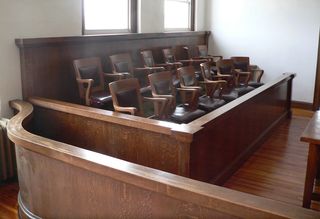Bias
Juries, Lawyers, and Race Bias
A new study asks whether lawyers are aware of the racial biases of jurors.
Posted July 22, 2016

Juries are a central part of the legal system in many countries. A jury of ordinary citizens is asked to evaluate the evidence in criminal cases. Ideally, of course, juries would be swayed only by the evidence presented as it relates to the law. In reality, people’s biases affect their evaluation of what they see and hear.
For more than a decade, research has focused on sources of bias. This work distinguishes between explicit bias and implicit bias. Explicit bias occurs when people deliberately choose to think and act in ways that harm a group. Implicit bias occurs when the knowledge and associations a person has affect their evaluations of what is going on in the world, even if they are unaware of that influence.
Consider a racially biased juror who has a negative attitude toward African Americans. An explicitly biased juror might choose to vote that a black defendant is guilty regardless of the evidence.
In real trials, though, most evidence is ambiguous. An eyewitness gives confident testimony that the defendant committed the crime, but the eyewitness was far from the scene. The defendant has an alibi, but it requires corroboration from two people who seem untrustworthy. As a result, there is a lot of room for interpretation of the strength of the evidence. An implicitly biased juror might be prone to interpret the evidence favorably toward the prosecution when the defendant is black.
This kind of implicit bias is particularly problematic, because jurors are not aware that their beliefs are affecting their interpretation of the evidence.
One of the safeguards the legal system has for bias in jurors is the voir dire process. When a jury trial begins, lawyer have the opportunity to question potential jurors. They are given a limited number of peremptory challenges to jurors in which a particular member of the jury pool can be removed from the trial without having to justify the removal. In this way, if a lawyer feels that a juror is biased, the lawyer can prevent that individual from serving on a jury.
A fascinating paper by Mike Morrison, Amanda DeVaul-Fetters and my University of Texas colleague Bertram Gawronski in the August 2016 issue of Personality and Social Psychology Bulletin explored how real lawyers use their challenges to see how they deal with racial bias.
They proposed that lawyers might try to get jurors whose biases are most compatible with their case. Imagine a case with a white victim and a black defendant. The prosecutor—who wants to see the defendant convicted—might want people who are racially biased against blacks on the jury, because their bias will favor conviction. In contrast, the defense attorney—who wants to see the defendant acquitted—might want people on the jury who are not racially biased, because the absence of bias would be more favorable to the defendant.
To test this possibility, the authors first asked practicing attorneys to list the kinds of questions they normally ask during voir dire. From these, they selected 30 questions that are commonly asked. These were questions like race, political identity (liberal/conservative) and whether the potential juror has friends or relatives in law enforcement.
Then, a jury pool was formed from a group of almost 300 people who were drawn from a nationwide American sample from a polling company. These individuals answered the 30 voir dire questions and also did two measures of racial bias. One was an explicit measure in which people were asked questions about racial bias. The second was the racial Implicit Association Test. The IAT asks people to respond to words that are positive (like flowers) with one hand and words that are negative (like cancer) with the other. Participants are also shown names that are stereotypically given to White people or stereotypically given to Black people. On some blocks, participants respond to positive words and White names with one hand and negative words and Black names with the other hand. On other blocks, participants respond to positive words and Black names with one hand and negative words and Black names with the other.
The idea is that if people have an implicit bias against Black people, they will slower to respond in the Black/positive blocks than in the Black/negative blocks. So, the difference in speed to respond in these blocks is used a measure of implicit bias.
Finally, a group of attorneys was drawn from a national sample for the critical part of the study. They were given a role in a fictitious trial. Half were assigned to be defense attorneys and half were assigned to be prosecuting attorneys. For half of the participants the victim was White and the defendant was Black. For the other half, the victim was Black and the defendant was White.
Attorneys were randomly shown 22 juror profiles drawn from the 300 people described earlier. They could select which of the 30 questions they wanted answers to. The attorneys were not shown the people’s scores on the measures of explicit and implicit bias. Attorneys were allowed to strike 10 jurors, leaving them with a jury of 12 people.
The question is whether attorneys tend to select people who will be favorable to their case.
There were no differences in the jurors who were removed or kept on the jury based on the explicit measure of racial bias. The interesting effects occurred for the measure of implicit bias.
When the case had a Black victim and a White defendant, there was little difference in the implicit racial bias of the jurors who were selected and rejected for the case. When the case had a White victim and a Black defendant, differences emerged. Prosecuting attorneys tended to favor keeping racially biased jurors and rejecting unbiased jurors. Defense attorneys tended to favor rejecting racially biased jurors and keeping unbiased jurors.
That is, the attorneys were using the answers to the questions to find jurors who would be most favorable to their case.
Part of the way they did this is obvious. When the defendant was Black, prosecuting attorneys tended to reject Black jurors and defense attorneys tended to keep Black jurors. However, that did not explain the entire effect. The attorneys were also using something about the answers to the questions to identify racial bias. Unfortunately, the authors did several analyses of the questions and were unable to identify what information attorneys were using that gave them this insight.
These data suggest that attorneys have some skill at identifying people who are likely to be favorably predisposed to the case they are making. They use the jury selection process to find jurors whose implicit biases will help them to win the case. Much more work needs to be done, though to figure out exactly how they are uncovering this implicit bias.
Follow me on Twitter.
And on Facebook and on Google+.
Check out my book Smart Change.
And my books Smart Thinking and Habits of Leadership
Listen to my radio show on KUT radio in Austin Two Guys on Your Head and follow 2GoYH on Twitter and on Facebook. The show is available on iTunes and Stitcher.




